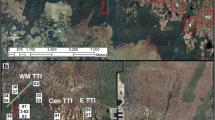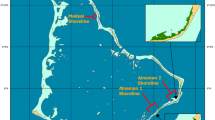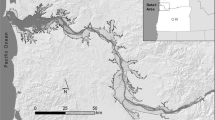Abstract
Currently, mangroves dominate the tidal wetlands of Tampa Bay, Florida, but an examination of historic navigation charts revealed dominance of tidal marshes with a mangrove fringe in the 1870s. This study's objective was to conduct a new assessment of wetland change in Tampa Bay by digitizing nineteenth century topographic and public land surveys and comparing these to modern coastal features at four locations. We differentiate between wetland loss, wetland gain through marine transgression, and a wetland conversion from marsh to mangrove. Wetland loss was greatest at study sites to the east and north. Expansion of the intertidal zone through marine transgression, across adjacent low-lying land, was documented primarily near the mouth of the bay. Generally, the bay-wide marsh-to-mangrove ratio reversed from 86:14 to 25:75 in 125 years. Conversion of marsh to mangrove wetlands averaged 72 % at the four sites, ranging from 52 % at Old Tampa Bay to 95 % at Feather Sound. In addition to latitudinal influences, intact wetlands and areas with greater freshwater influence exhibited a lower rate of marsh-to-mangrove conversion. Two sources for nineteenth century coastal landscape were in close agreement, providing an unprecedented view of historic conditions in Tampa Bay.










Similar content being viewed by others
References
Anderson, J.F., E.E. Hardy, J.T. Roach, and R.E. Witmer. 1976. A land use and land cover classification system for use with remote sensor data. Washington: U.S. Geological Survey. Prof. Paper 964.
Ball, M.C. 1988. Ecophysiology of mangroves. Trees-Structure and Function 2: 129–142.
Boak, E.H., and I.L. Turner. 2005. Shoreline definition and detection: A review. Journal of Coastal Research 21: 688–703.
Bostrom, C., S.J. Pittman, C. Simenstad, and R.T. Kneib. 2011. Seascape ecology of coastal biogenic habitats: Advances, gaps, and challenges. Marine Ecology Progress Series. 427: 191–217.
Bourdo Jr., E.A. 1956. A review of the General Land Office Survey and of its use in quantitative studies of former forests. Ecology 37: 754–768.
Breitfuss, M.J., R.M. Connolly, and P.E.R. Dale. 2003. Mangrove distribution and mosquito control: Transport of Avicennia marina propagules by mosquito-control runnels in southeast Queensland saltmarshes. Estuarine, Coastal and Shelf Science 56: 573–579.
Brinson, M.M., R.R. Christian, and L.K. Blum. 1995. Multiple states in the sea-level induced transition from terrestrial forest to estuary. Estuaries and Coasts 18: 648–659.
Bromberg, K.D., and M.D. Bertness. 2005. Reconstructing New England salt marsh losses using historical maps. Estuaries and Coasts 28: 823–832.
Cabanes, C., A. Cazenave, and C. Le Provost. 2001. Sea level rise during past 40 years determined from satellite and in situ observations. Science 294: 840–842.
Christian, R.R., L.E. Stasavich, C.R. Thomas, and M.M. Brinson. 2002. Reference is a moving target in sea-level controlled wetlands. In Concepts and controversies in tidal marsh ecology, ed. M.P. Weinstein and D.A. Kreeger, 805–825. Norwell: Kluwer Academic Publishers.
Cicchetti, G., and H. Greening. 2011. Estuarine biotope mosaics and habitat management goals: An application in Tampa Bay, FL, USA. Estuaries and Coasts 34: 1278–1292.
Clewell, A.F. 1997. Vegetation. In Ecology and management of tidal marshes: A model from the Gulf of Mexico, ed. C.L. Coultas and Y.P. Hsieh, 77–110. Delray Beach: St. Lucie Press.
Comeaux, R.S., M.A. Allison, and T.S. Bianchi. 2012. Mangrove expansion in the Gulf of Mexico with climate change: Implications for wetland health and resistance to rising sea levels. Estuarine, Coastal and Shelf Science 96: 81–95.
Cowardin, L.M., V. Carter, F.C. Carter, and E.T. LaRoe. 1979. Classification of wetlands and deepwater habitats of the United States. Washington: U.S. Dept. of the Interior. Fish and Wildlife Service. Office of Biological Services. FWS/OBS-79/31.
Crain, C.M., L.K. Albertson, and M.D. Bertness. 2008. Secondary succession dynamics in estuarine marshes across landscape-scale salinity gradients. Ecology 89: 2889–2899.
Crowell, M., S.P. Leatherman, and M.K. Buckley. 1991. Historical shoreline change: Error analysis and mapping accuracy. Journal of Coastal Research 7: 839–852.
Crumpacker, D.W., E.O. Box, and E.D. Hardin. 2001. Temperate-subtropical transition areas for native woody plant species in Florida, USA: Present locations, predicted changes under climatic warming, and implications for conservation. Natural Areas Journal 21: 136–148.
Daleo, P., and O. Iribarne. 2009. Beyond competition: The stress-gradient hypothesis tested in plant-herbivore interactions. Ecology 90: 2368–2374.
Day, J.W., R.R. Christian, D.M. Boesch, A. Yanez-Arancibia, J. Morris, R.R. Twilley, L. Naylor, L. Schaffner, and C. Stevenson. 2008. Consequences of climate change on the ecogeomorphology of coastal wetlands. Estuaries and Coasts 31: 477–491.
Delcourt, H.R., and P.A. Delcourt. 1977. Pre-settlement magnolia-beech climax of the Gulf Coastal Plain: Quantitative evidence from the Apalachicola River Bluffs, north-central Florida. Ecology 58: 1085–1093.
Dolan, R., S. Trossbach, and M. Buckley. 1990. New shoreline erosion data for the Mid-Atlantic Coast. Journal of Coastal Research 6: 471–479.
Donnelly, J.P., and M.D. Bertness. 2001. Rapid shoreward encroachment of salt marsh cordgrass in response to accelerated sea-level rise. Proceedings of the National Academy of Sciences 98: 1418–1423.
Eleuterius, L.N. 1990. Tidal marsh plants. Gretna: Pelican Publishing Co.
Estevez, E.D., R.K. Evans, and C.A. Palmer. 1990. Distribution and abundance of marshes, mangroves and submerged aquatic vegetation in tidal waters of the Myakka River, Sarasota County, Florida. Sarasota: Mote Marine Laboratory. Technical Report No. 196.
Fehring, W.K. 1986. Data bases for use in fish and wildlife mitigation planning in Tampa Bay, Florida: Project summary. Tampa: U.S. Fish and Wildlife Service. NWRC Open-File Report 86–6.
Gedan, K.B., B.R. Silliman, and M.D. Bertness. 2009. Centuries of human-driven change in salt marsh ecosystems. Annual Review of Marine Science 1: 117–141.
Haddad, K.D. and E.A.J. Joyce. 1997. Management. In Ecology and Management of Tidal Marshes, eds. C.L. Coultas and Y.P. Hsieh. 309–330. Delray Beach, Florida: St Lucie Press
Jackson, J.B.C., M.X. Kirby, W.H. Berger, K.A. Bjorndal, L.W. Botsford, B.J. Bourque, R.H. Bradbury, R. Cooke, J. Erlandson, and J.A. Estes. 2001. Historical overfishing and the recent collapse of coastal ecosystems. Science 293: 629–637.
Janicki, A.J., D.L. Wade, and D.E. Robison. 1995. Habitat protection and restoration targets for Tampa Bay. St. Petersburg: Tampa Bay National Estuary Program. Technical Publication #07-93.
Jansen, L.J.M., G. Groom, and G. Carrai. 2008. Land-cover harmonisation and semantic similarity: Some methodological issues. Journal of Land Use Science 3: 131–160.
Jones, P.D., and A. Moberg. 2003. Hemispheric and large-scale surface air temperature variations: An extensive revision and an update to 2001. Journal of Climate 16: 206–223.
Kangas, P.C., and A.E. Lugo. 1990. The distribution of mangroves and saltmarsh in Florida. Tropical Ecology 31: 32–39.
Krauss, K.W., A.S. From, T.W. Doyle, T.J. Doyle, and M.J. Barry. 2011. Sea-level rise and landscape change influence mangrove encroachment onto marsh in the Ten Thousand Islands region of Florida, USA. Journal of Coastal Conservation 15(4): 629–638.
Krebs, J.M., A.B. Brame, and C.C. McIvor. 2007. Altered mangrove wetlands as habitat for estuarine nekton: Are dredged channels and tidal creeks equivalent? Bulletin of Marine Science 80: 839–861.
LABINS. Land Boundary Information System. 2003. General Land Office Early Records. Florida Department of Environmental Protection. Township Plats, Survey Notes, & Surveyor Instructions. http://data.labins.org/2003/index.cfm. Accessed 12 May 2011.
Levitus, S., J.I. Antonov, T.P. Boyer, and C. Stephens. 2000. Warming of the world ocean. Science 287: 2225–2229.
Lewis, R.R., III and E.D. Estevez. 1988. The ecology of Tampa Bay, Florida: An estuarine profile. U.S. Fish and Wildlife Service. U.S. Dept. of the Interior. BR-85(7.18)
Lewis III, R.R., and D. Robison. 1996. Setting priorities for Tampa Bay habitat protection and restoration: Restoring the balance, 09–95. Tampa: Tampa Bay National Estuary Program Technical Publication.
Marella, R.L. 2004. Water Withdrawals, Use, Discharge, and Trends in Florida, 2000. U.S. Geological Survey Scientific Investigations Report 2004–5151.
Marshall, C.H., R.A. Pielke Sr., L.T. Steyaert, and D.A. Willard. 2004. The impact of anthropogenic land-cover change on the Florida Peninsula sea breezes and warm season sensible weather. Monthly Weather Review 132: 28–52.
McKee, K.L. 1996. Growth and physiological responses of neotropical mangrove seedlings to root zone hypoxia. Tree Physiology 16: 883–889.
McKee, K.L., and J.E. Rooth. 2008. Where temperate meets tropical: Multi-factorial effects of elevated CO2, nitrogen enrichment, and competition on a mangrove-salt marsh community. Global Change Biology 14: 971–984.
Mitsch, W.J., and J.G. Gosselink. 2000. Wetlands, 3rd ed. New York: Wiley.
Montague, C.L., and R.G. Weigert. 1990. Chapter XIV: Salt marshes. In Ecosystems of Florida, ed. R.L. Myers and J.J. Ewel, 481–516. Orlando: University of Central Florida Press.
Mustard, J.F., M.A. Carney, and A. Sen. 1999. The use of satellite data to quantify thermal effluent impacts. Estuarine, Coastal and Shelf Science 49: 509–524.
NASA. 2007. GISS surface air temperature analysis. http://data.giss.nasa.gov/. Accessed 12 May 2011.
NOAA. 2001. Sea levels online. http://tidesandcurrents.noaa.gov/sltrends/sltrends.html. Accessed 12 May 2011.
Odum, W.E., and C.C. McIvor. 1990. Chapter 15: Mangroves. In Ecosystems of Florida, ed. R.L. Myers and J.J. Ewel, 517–548. Orlando: University of Central Florida Press.
Orlando, S.P.J., L.P. Rozas, G.H. Ward, and C.J. Klein. 1993. Salinity characteristics of Gulf of Mexico estuaries. Silver Spring: National Oceanic and Atmospheric Administration, Office of Ocean Resources Conservation and Assessment.
Parmesan, C., and G. Yohe. 2003. A globally coherent fingerprint of climate change impacts across natural systems. Nature 421: 37–42.
Patterson, S., K.L. McKee, and I.A. Mendelssohn. 1997. Effects of tidal inundation and predation on Avicennia germinans seedling establishment and survival in a sub-tropical mangal/salt marsh community. Mangroves and Salt Marshes 1: 103–111.
PBS&J. 2010. Tampa Bay Estuary Program Habitat Master Plan Update. Tampa, FL: Technical Report #06–09.
Pennings, S.C., B. Grant, and M.D. Bertness. 2005. Plant zonation in low-latitude salt marshes: Disentangling the roles of flooding, salinity and competition. Ecology 93: 159–167.
Raabe, E.A., and Stumpf, R.P., 1997, Assessment of acreage and vegetation change in Florida's Big Bend tidal wetlands using satellite imagery: Proceedings of the Fourth International Conference on Remote Sensing for Marine and Coastal Environments, Orlando, FL, 17-19 March, 1997, I:84-93.
Raabe, E.A., A.E. Streck and R.P. Stumpf. 2004. Historic topographic sheets to satellite imagery: A methodology for evaluating coastal change in Florida’s big bend tidal marsh. U.S. Geological Survey Open-File Report 02–211.
Ross, M.S., J.F. Meeder, J.P. Sah, P.L. Ruiz, and G.J. Telesnicki. 2000. The Southeast Saline Everglades revisited: 50 years of coastal vegetation change. Journal of Vegetation Science 11: 101–112.
Saintilan, N., K. Rogers, and K. McKee. 2009. Salt marsh-mangrove interactions in Australia and the Americas. In Coastal wetlands: An integrated approach, ed. G. Perillo, E. Wolanski, D. Cahoon, and M. Brinson, 855–883. New York: Elsevier.
Schrope, M. 2008. Sleeping with the fishes. Nature Reports Climate Change 159–160.
Schwartz, M.W. 1994. Natural distribution and abundance of forest species and communities in northern Florida. Ecology 75: 687–705.
Seaman Jr., W. 1985. Florida aquatic habitat and fishery resources. Eustis: Florida Chapter of the American Fisheries Society.
Shalowitz, A.L. 1962. Shore and sea boundaries: With special reference to the interpretation and use of Coast and Geodetic Survey data. Washington: U.S. Dept. of Commerce, Coast and Geodetic Survey.
Smith III, T.J., G. Tiling, and P.S. Leasure. 2007. Restoring coastal wetlands that were ditched for mosquito control: A preliminary assessment of hydro-leveling as a restoration technique. Journal of Coastal Conservation 11: 67–74.
Stevens, P.W., S.L. Fox, and C.L. Montague. 2006. The interplay between mangroves and saltmarshes at the transition between temperate and subtropical climate in Florida. Wetlands Ecology and Management 14: 435–444.
Stoker, Y.E., V.A. Levesque and W.M. Woodham. 1996. The effect of discharge and water quality of the Alafia River, Hillsborough River, and the Tampa Bypass Canal on nutrient loading to Hillsborough Bay, Florida. U.S. Geological Survey. Water Resources Investigations Report 95–4107.
Stout, J.P. 1984. The ecology of irregularly flooded salt marshes of the Northeastern Gulf of Mexico: A community profile. Washington: National Coastal Ecosystems Team, Fish and Wildlife Service. Biogical Report 85 (7.1).
Swainson, O.W. 1928. Topographic manual. Washington: U.S. Coast and Geodetic Survey. Special Publication No. 144.
SWFWMD. Southwest Florida Water Management District. 2005. Land use/land cover 1999, FLUCCS. http://www.swfwmd.state.fl.us/data/gis/layer_library/. Accessed 12 May 2011.
SWFWMD. Southwest Florida Water Management District. 2006. Lower Hillsborough River low flow study results and minimum flow recommendation. Brooksville: SWRWMD.
TBRPC. 2006. Sea level rise in the Tampa Bay Region. St. Petersburg: Tampa Bay Regional Planning Council.
Templeton, R.W. 1845. U.S. Government Survey Field Notebooks: T30S R16E, V109:11.
Thompson, P. 2010. Climate change in our own backyard: Rising seas make Tampa Bay coastline more vulnerable. St. Petersburg: St. Petersburg Times.
Tingle, J.L., C.V. Klimas, and T.L. Foti. 2001. Application of General Land Office Survey notes to bottomland hardwood ecosystem management and restoration in the Lower Mississippi Valley: An example from Desha County, Arkansas. Asheville: Department of Agriculture, Forest Service, Southern Research Station. Gen. Tech. Rep. SRS 42.
Van Dyke, E., and K. Wasson. 2005. Historical ecology of a Central California estuary: 150 years of habitat change. Estuaries and Coasts 28: 173–189.
Wang, Y.C. 2005. Presettlement land survey records of vegetation: Geographic characteristics, quality and modes of analysis. Progress in Physical Geography 29: 568–598.
Wiegert, R.G. and B.J. Freeman. 1990. Tidal salt marshes of the Southeast Atlantic Coast: A community profile. U.S. Fish and Wildlife Service Biological Report 71.
Williams, K., K.C. Ewel, R.P. Stumpf, F.E. Putz, and T.W. Workman. 1999. Sea-level rise and coastal forest retreat on the west coast of Florida, USA. Ecology 80: 2045–2063.
Williamson, G.J., G.S. Boggs, and D.M.J.S. Bowman. 2011. Late 20th century mangrove encroachment in the coastal Australian monsoon tropics parallels the regional increase in woody biomass. Regional Environmental Change 11: 19–27.
Wolfe, S.H., and R.D. Drew. 1990. Ecological characterization of the Tampa Bay watershed. Tallahassee: U.S. Fish and Wildlife Service.
Woodroffe, C.D., and J. Grindrod. 1991. Mangrove biogeography: The role of quaternary environmental and sea-level change. Journal of Biogeography 18: 479–492.
Yates, K.K., H. Greening and G. Morrison. 2011. Integrating science and resource management in Tampa Bay, Florida. U.S. Geological Survey Circular 1348. 280.
Zervas, C.E. 2001. Sea level variations of the United States, 1854–1999. Silver Spring: U.S. Dept. of Commerce, National Oceanic and Atmospheric Administration. NOAA Technical Report NOS CO-OPS 36.
Acknowledgments
Our thanks to Randy Runnels, Yvonne Stoker, and Terry Edgar for subject and regional expertise, Justin Krebs and Adam Brame for field support, Jordan Sanford for digitizing, and anonymous reviewers whose efforts improved earlier versions of this manuscript. Funding for this study was provided by two U.S. Geological Survey programs: the Coastal and Marine Geology Program Tampa Bay Integrated Science Project and the Ecosystems Program.
Author information
Authors and Affiliations
Corresponding author
Rights and permissions
About this article
Cite this article
Raabe, E.A., Roy, L.C. & McIvor, C.C. Tampa Bay Coastal Wetlands: Nineteenth to Twentieth Century Tidal Marsh-to-Mangrove Conversion. Estuaries and Coasts 35, 1145–1162 (2012). https://doi.org/10.1007/s12237-012-9503-1
Received:
Revised:
Accepted:
Published:
Issue Date:
DOI: https://doi.org/10.1007/s12237-012-9503-1




